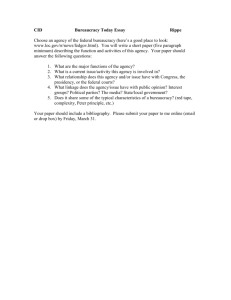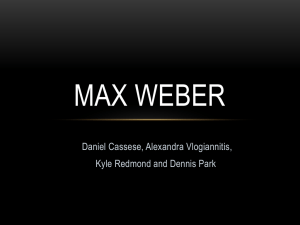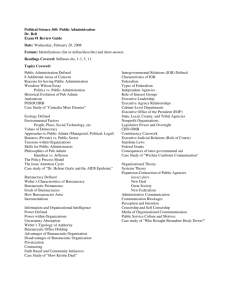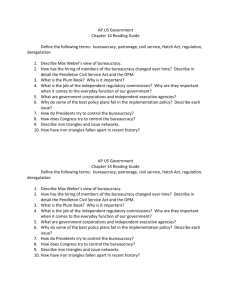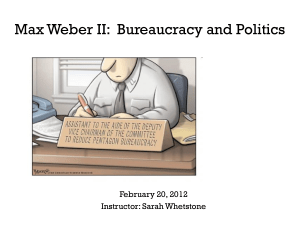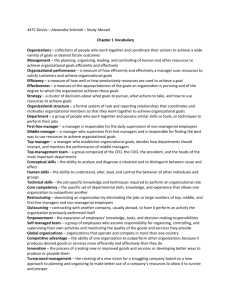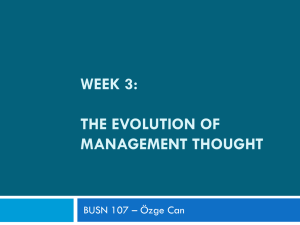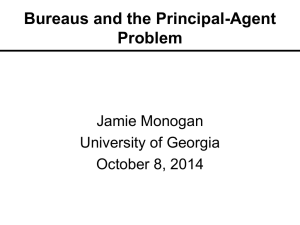The organizational society
advertisement
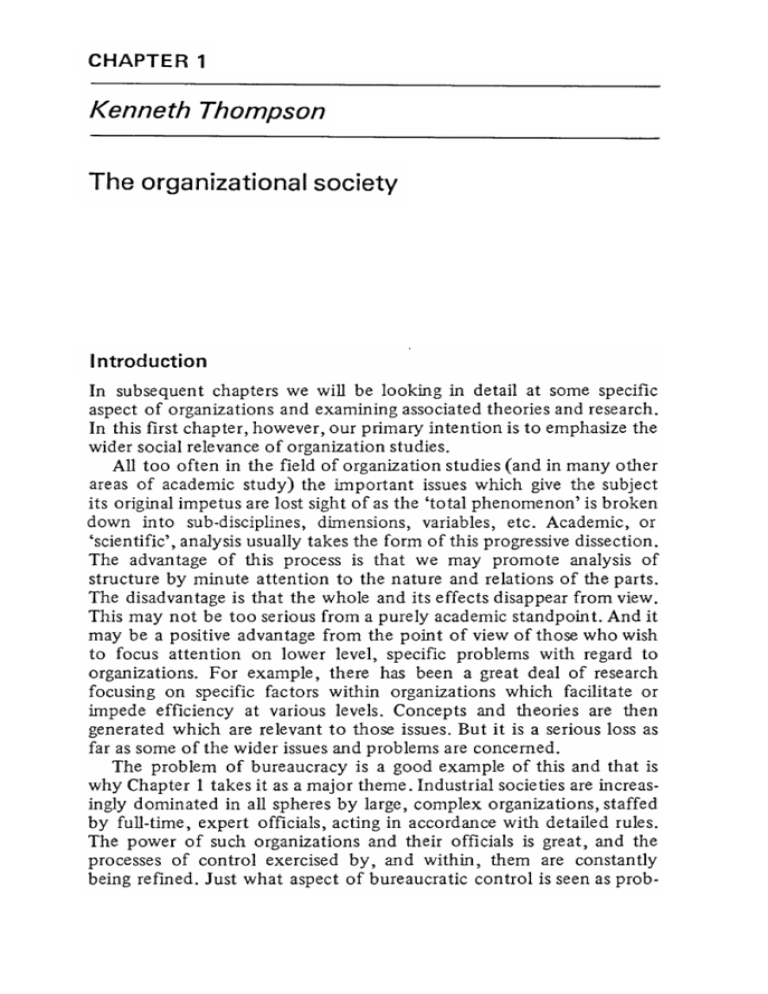
CHAPTER 1 Kenneth Thompson The organizational society Introduction In subsequent chapters we will be looking in detail at some specific aspect of organizations and examining associatedtheories and research. In this first chapter, however, our primary intention is to emphasizethe wider social relevanceof organization studies. All too often in the field of organization studies (and in many other areas of academic study) the important issues which give the subject its original impetus are lost sight of as the 'total phenomenon' is broken down into sub-disciplines, dimensions, variables, etc. Academic, or 'scientific ' , analysis usually takes the form of this progressivedissection. The advantage of this process is that we may promote analysis of structure by minute attention to the nature and relations of the parts. The disadvantageis that the whole and its effects disappear from view. This may not be too serious from a purely academic standpoint . And it may be a positive advantage from the point of view of those who wish to focus attention on lower level, specific problems with regard to organizations. For example, there has been a great deal of research focusing on specific factors within organizations which facilitate or impede efficiency at various levels. Concepts and theories are then generated which are relevant to those issues. But it is a serious loss as far as some of the wider issuesand problems are concerned. The problem of bureaucracy is a good example of this and that is why Chapter 1 takes it as a major theme. Industrial societies areincreasingly dominated in all spheres by large, complex organizations, staffed by full -time , expert officials , acting in accordance with detailed rules. The power of such organizations and their officials is great, and the processes of control exercised by , and within , them are constantly being refined . Just what aspect of bureaucratic control is seenas prob - 4 Control and ideology in organizations lematic depends on the particular values and concerns of the observer. This chapter concentrates on aspects connected with the deceptive control exercised by seemingly 'impersonal' processes, and the alienating effects on individuals . It does not pursue other aspects, such as the influential criticism by Talcott Parsons and Alvin Gouldner of earlier conceptualizations of bureaucracy on the grounds that they did not distinguish between authority based on expertise and that based on position in a hierarchy . (Cf. Albrow 1970.) On the whole , our emphasis is on the great extent to which bureaucratic hierarchies successfully co-opt expertise into their control systems. 1 The concept of bureaucracy There has been a widespread political concern about bureaucracy for more than two hundred years. It was thought by the English to be a French 'disease', and the view was shared by some Frenchmen: Balzac's novel of 1836, Les Employ es, has been described as being at least half a treatise on bureaucracy, and in it he set the vituperative tone for many subsequent discussionsof the subject: '. . . Bureaucracy, the giant power wielded by pigmies . . .' (Albrow 1970 p . 18) . The 'disease' spread, however, and we find a motion condemning 'the continued growth of bureaucracy' being put forward in the House of Commons in 1968. Max. Weber, the German sociologist, was responsible for providing the most influential and systematic social scientific analysis of the phenomenon of bureaucracy. He judged it to be the most important development of modem industrial society - indispensable to both capitalism and socialism: The development of the modern fonn of the organization of corporate groups in all fields is nothing less than identical with the development and continued spread of bureaucratic administration . This is true of church and state, of annies, political parties, economic enterprises, organizations to promote all kinds of causes, private associations, clubs, and many others . . . Its development, largely under capitalistic auspices, has created an urgent need for stable, strict , intensive, and calculable administration . It is this need which gives bureaucracy a crucial role in our society as the central element in any kind of large-scaleadministration . (Weber 1964 pp 337 - 8) Bureaucracy has certainly been a problem for democrats in capitalist societies (the problem of controlling multinational corporations is an The organizational example , and ' red as are tape Marx issues ' ) tended , society ) it bring about , and the experience the the state ( course This in , is our revocable with the proletarian ' of large withering , an to the slavery 1970 - each in - , 8 this is , in then of become a special our will of can a section must and the gradual will finally an similarity control be population of no of will the the on creation - . with , to functions of ) start bearing simple habit ' degrees beginning gradual order the - keepers and lead an of as book types a the , role instructions and Such itself to more , own the and . which and reduce " sorts our supported will we , more will what on on discipline we all marks order production ' foremen bureaucracy an would relying out revolution quotation , functions 57 all becoming turn special pp of without wage , iron ; of production ' order accounting by - scale away order task a and unrealistic - scale carrying proletarian for state sound , , paid technicians . 1975 to bureaucracy large simply of , societies - Diaz to created strict modestly aid the organize workers of , accomplishing basis that Perez socialist already armed individual : establishing the to , of , of officials responsible will the socialist relation began new bureaucracy has workers power state , capitalism as by see Lenin of of for in the away workers privacy problem although realist how the a bureaucracy great what , of ( on explaining , of less subject withering ourselves power no ideas the to service been the ' s even basis civil has Marx came We the it neglect of when of but to discussion 5 society and performed die out . ( as Lenin ) 1.1 Control 'Bureaucracy' is a good concept to begin with in starting a book on organizations because it has proved so durable and flexible in expressing so many of the concerns that people have had about their own relations with organizations. The quotations at the beginning of this chapter express some of these concerns as they have been felt by people with varied interests and outlooks . Most of these concerns can be summed up under the heading of control . They are concerns having to do with the ways in which modern complex organizations exercise control in society - both internally with respect to their members, and externally with respect to their environment . Most of the early writers on bureaucracy had this as their major interest (e.g. Max Weber and Robert Michels especially) and they would not have thought it fruitful to divorce questions of internal organizational control from issues of external control . Their belief that the two sets of issuesare intimately related was probably well founded , and the study of organizations is impoverished when it rigidly separatesthem. We will reject the kind of 6 Control and ideol Qgy in organizations view that suggests the modern study of organizations is necessarily different in this respect , as for instance in the unfortunate distinctions drawn in the second half of the following statement : In modern society it is impossible to escape from the influence of organizations of one type or another . It was an awareness of this influence that encouraged the early sociologists to develop their interest in organizations . As seen already , however , this interest differs from the interest of present -day sociologists . The difference between the two is not simply the difference between the levels of analysis - whether macro or micro - but also between an interest in the external political sphere of society and the internal political structure of the organizations . ( Dunkerley 1972 p 2) In fact , it can be argued that the central questions for sociologists in this field are still those posed by Weber. His achievement was precisely in showing how systems of internal organizational control were intimately related to wider systems of control of social action . In particular , it should be made clear that , although the earlier, nineteenth-century interest in bureaucracy was a reflection of a debate about the place of public officials in developing governmental machines, it was still a debate about who (which people) control whom . Weber was a pivotal figure for the subsequent development of this debate in a direction which makes it relevant to current issues. For he represents a shift from this older perspective, with which he began, to a concern with the control of men by organizational rules - control by impersonal rather than personal factors. In other words, whilst it may be true that nineteenthcentury writers on bureaucracy focused on the problem of the civil service in a democracy, the modern sociology of organizations' concern, stemming from Weber, is with the relation between organizational systems of action and the individual actor . 2 Different uses of the concept Although social scientists are often accused of inventing unnecessary new terminology to conceal a poverty of ideas, the failing is somewhat different in the caseof the term bureaucracy. Here there seemsto be a 'poverty of terminological inventiveness' or , more specifically , a process of 'terminological conservation and conceptual change' (Albrow 1970 pp 120- 3) . The same term is used to refer to a variety of things, depending on the particular interest of the layman or social scientist concerned. We will confine ourselves to discussing two of the most 7 The organizational society influential usages: bureaucracy as rational organization , and bureaucracy as modern society. 2 . 1 Bureaucracy as rational organization Most of the social scientists who adopt this conceptual strategy claim to be following the usage of Max Weber, but , they would add, only after first correcting Weber's conceptual ambiguity . For example, Peter Blau states: Weber conceived of bureaucracy as a social mechanism that maximizes efficiency and also as a form of social organization with specific characteristics. Both these criteria cannot be part of the definition , since the relationship between the attributes of a social institution and its consequencesis a question for empirical verification and not a matter of definition (B1au 1963 p 251). Blau and others choose to interpret Weber's description of bureaucracy as 'rational organization' as being a definition of bureaucracy in the sense of an 'organization that maximizes efficiency in administration ' . (Blau 1956 p. 60) They then fInd this to be inconsistent with what they take to be his list of a priori essential characteristics of bureaucratic organization . Blau states that Weber saw the following list of characteristics as making up his 'ideal' , pure or most rational type of bureaucracy: 1 2 3 4 5 specialization of tasks; a hierarchy of authority ; a system of rules; impersonality ; employment based on technical qualifications , and constituting a career; 6 efficiency . (Blau 1956 pp 28- 31) Blau then goes on to show that efficiency may not alwaysbe best served by some of the other characteristics in the list . For example, he notes that in his own study of a federal law-enforcement agency, efficiency was often best servedby unofficial practices and informal personal relations among the staff , in contravention of the rules and disregarding formal impersonal structures. One of his major conclusions was that : 'Maximum rationality in the organization, therefore , depends on the ability of operating officials to assume the initiative in establishing informal relations and instituting unofficial practices that eliminate 8 Control and ideology in organizations operational difficulties as they occur.' (Blau 1963 p. 255) But Blau is misleading in suggestingthat Weber equated rationality with efficiency . In referring to the formal rationality of bureaucracy, Weber had in mind formal procedures involving correct calculation either in numerical terms, as with fmance and statistics, or in logical terms , as with law . Such calculations are formal procedures which allow us to determine what level of efficiency has been reached, but they do not in themselves guarantee efficiency . To put it another way : Weber was all too aware that formal rationality did not guarantee material or substantive rationality (the most efficient attainment of goals or values) . He sometimes spoke of the 'paradox of consequences' whereby highly rational procedures frustrated or defeated the purposes and values which had inspired them . For example, bureaucracy might be democracy ' s most its worst rational enemy form of administration , but sometimes it was also . In fact , far from Weber's defmition of the concept of bureaucracy being set in the context of a discussion of organizational efficiency , it is set in the context of a larger discussionof authority as a form of control (or 'imperative co-ordination ') . He distinguished between power and authority along the lines that , whereas power referred to any relationship where one member could enforce his will despite resistance, authority existed when obedience to commands rested on a belief in their legitimacy - a belief that orders were justified and that it was right to obey. It was this idea of legitimacy which provided him with his criterion for classifying organizations. Along with different forms of belief in the legitimacy of authority went different authority structures and corresponding forms of organization . Three kinds of authority were distinguished: charismatic authority , based on the sacredor outstanding characteristic of the individual ; traditional authority , based on respect for custom; rational legal authority , based on a code of legal rules and regulations.! The purest type of exercise of rational legal authority was that which employed a bureaucratic administrative staff . Weber ' s full list of ten bureaucratic characteristics should not be taken in isolation from his longer list of preceding propositions on legitimacy and authority . He first of all set out five related beliefs on which the legitimacy of legal authority depended; this was followed by eight propositions about the structuring of legal authority systems; and finally , the ten characteristics of bureaucratic administration based on 1 Of course most organizations contain a mixture of all these elements , but Weber was concerned with distinguishing the most logically pure types of combinations of authority and administration . These were not simply abstract types , however , but were typical of actual historical periods and circumstances . Theorganizational society 9 these rational legal principles. The legitimacy of legal authority depends on the following beliefs: i That a legal code can be established which can claim obedience from members of the organization . ii That the law is a system of abstract rules which are applied to particular cases; and that administration looks after the interests of the organization within the limits of that law . iii That the man exercising authority also obeys this impersonal order . iv That only qua member does the member obey the law. v That obedience is due not to the person who holds the authority but to the impersonal order which has granted him this position . (Albrow 1970 pp 43- 5) On the basis of these conceptions of legitimacy Weber formulated his propositions about the structuring of legal authority systems: a Official tasks are organized on a continuous , regulated basis. b These tasks are divided into functionally distinct spheres, each furnished with the requisite authority and sanctions. c Offices are arranged hierarchically , the rights of control and complaint being specified. The rules according to which work is conducted may be either technical or legal. In both casestrained men are necessary. The resources of the organization are quite distinct from those of the members as private individuals . The office holder cannot appropriate his office . Administration is based on written documents and this tends to make the office ( Bureau) the hub of modern organization . Legal authority systems can take many forms, but are seenat their purest in a bureaucratic administrative staff . (Albrow 1970 pp 43- 5) Bureaucracy in its most rational form presupposed the preceding propositions on legitimacy and authority , and had the following characteristics : 1 The staff membersare personallyfree, observingonly the impersonal dutiesof their offices. 2 3 There is a clear hierarchy of offices . The functions of offices are clearly specified. 10 4 5 6 7 8 9 10 Control and ideology in organizations Officials are appointed on the basis of a contract . They are selected on the basis of a professional qualification , ideally substantiated by a diploma gained through examination . They have a monetary salary, and usually pension rights. The salary is graded according to position in the hierarchy . The official can always leave the post, and under certain circumstances it may be terminated . The official 's post is his sole or major concern. There is a career structure , and promotion is possible either by seniority or merit , and according to the judgement of superiors. The official may appropriate neither the post nor the resources which go with it . He is subject to a unified control and disciplinary system. (Albrow 1970 pp 43- 5. This is an abbreviation from Weber 1964 pp 329- 34.) Weber's definition of rational organizationis, therefore, significantly different from those of many who thought they werefollowing him in conceptualizingbureaucracyas rational organization. The differenceis particularly evidentwhen Weber's whole theoreticalstanceis compared with that of the management theorists. The latter tend to defmeorganizations in a reified fashion as singleentities with goals. And rational organizationis then simply a matter of adoptingwhatevermeansare most efficient for attaining the goals. For Weber an organization ( Verband ) signifiedan orderingof socialrelationships,the maintenance of which certainindividualstook astheir specialtask. Thusthe presence of a leaderand usually an administrativestaff wasthe defmingcharacteristic of an organization. Furthennore, Weber regarded the fact that human behaviour was regularly oriented to a set of rules ( Ordnung ) as basic to sociological analysis . The existence of a distinctive set of rules governing behaviour was intrinsic to the concept of an organization . Without them it would not be possible to say what was and what was not organizational behaviour . . . Commands and rules ranked as equally important factors in the structuring of social relationships . In an administrative order they were linked in that the rules regulated the scope and possession of authority . ( A1brow 1970 pp 38 - 9) The spread of the bureaucratic form of organization to all spheres was part of a general process of rationalization in modern society. The reason why it would inevitably spread was becauseits characteristics of precision, continuity , discipline , strictness and reliability made it tech- 11 The organizational society nically to the most exercise satisfactory Bureaucracy skill , and that therefore the functioning rules summarized in signifies authority is refers Weber . delivered at the It a to the Which kind ( to use to state 1909 And less , as of we have with this denied of than discursively rationality machine position far . one bureaucratic specifically to on . No its rationality statements power has at ) the the - , he ' . But subject , argued , when different the , under it countries corrupt the machines greatest capitalistic which the German moment private officialdom direction of p64 the national expression business or in is ' Bureaucratic bound formal ' s is , formal rules technical Vienna And being The of Weber organization English purely , such them administration of . of an ) the norms importance . This ) of 361 The ' Bureaucratic 339 sense p with and apply knowledge p the achieved America of application of the bureaucracy and in in : 1964 noting . and statements 1964 confuse conference sought men rules interpret basis expert superiority German the ( Weber worth comparing France key ( Weber the not is ' technical came to did efficiency .' who - technical organizations to rational rules bureaucracy , on specifically analysable those experts the modern ' s .' by apply experts Weber character authority to of of for control able of organization . meant be and two rational seen , to technical of control knowledge govern of form organizational is more highly easily moral officialdom ? ' efficiency expansion open to enlightened ( Quoted ' , linked corruption authoritarianism in Albrow 1970 ) In other words conditions for describing the legal , authority - of in two and the it speed , unity , its success personal the and . spread transport demand for of production mass includes , equal wider list of other of bureaucracy the reduction by mass such of authority flies of modern in , democracy . Weber discretion , and society also communication methods , the growth and was , material in accounting a not : precision of up is ' s explanation industrial speed traditional triumph continuity and the administration its virtues in the that ' . Weber friction as was rational , and for , He with authority operational the sufficient . administration of ' efficiency citizens administration along reason of , priori goal of developments adoption treatment and of The word knowledge , kinds type . a went types single a Certain , the types the subordination costs favour in unambiguity strict that this other state organizational different . As all to any to quite charismatic out trying of contrast summarized for not administration other pushed adequately was attainment form accompanied spread Weber the thus offering the a 12 Control and ideology in organizations general theory of modern culture , centred on the processof progressive rationalization in all spheres. This leads us to the other common usage of the term bureaucracy: 2 .2 Bureaucracy as modern society Some theorists who have adopted this usagethink in terms of forms of organization simply reflecting the economic or political character of the larger society. This is the view of Marx . But it is possible to see the processoperating in the opposite direction as well so that bureaucratization is the subjection of society to the influence of the attitudes , values and techniques of bureaucrats. Why should this be the case? . The answer to this question of why bureaucracy asthe administrative form of rational legal authority should spread so easily is that it moves into the vacuum left by the disappearanceof administration based on traditional or charismatic types of authority . The control of members of modern organizations is rendered problematic becausetheir commitment or allegiance is so partial . This contrasts with a traditional order in which participation in one social activity was closely intertwined with participation in all other activities , and where all these activities were regulated on the basis of norms and values sanctioned by ancient custom (although often backed by force as well ) . When this basis of order disappearsthe only alternatives are: (a) coercion based on naked power, (b) allegiance to a charismatic figure as in some religious or political sects, or else, (c) acceptance of rational legal authority specific to each activity . Because such authority is activity -specific, and because members' commitments to that organizational activity are partial , there is a problem of control . Bureaucracy refers to the structure of control in organizations based on rational legal authority . As Perrow puts it : For our purposes then , the bureaucratic model refers to an organization which attempts to control extra-organizational influences (stemming from the characteristics of personnel and changesin the environment ) through the creation of specialized (staff ) positions and through such rules and devicesas regulations and categorization. (Perrow 1970 p 59) 3 Professionals and bureaucracy There are some social scientists who have so defined bureaucracy as to be able to contrast it with a fonn of organization that relies on professional expertise. In so doing they suggestthat the distinguishing characteristic of bureaucracy is a proliferation of detailed rules with close 7:iJe organizational society 13 surveillance to ensure members' observance of those rules. This is then contrasted with organization based on professionals who do not require detailed rules or close surveillance. Weber himself did not make any such distinction , although he would probably have regarded both professional organization and bureaucracy as forms of administration based on the legal rational principles , but differing in the degree of specificity of the rules. Perhaps the real difference between the two types is pointed out in the comment by Perrow: The less the obtrusive the cheap expertise , is to hire even unobtrusive the prima donna eunuch - the The of ends effect the this - programmed to involved : it , and Everyone professional . He work in complex even lawyers and control whole , salaried the responsibility non -professionals manages independent some to the the an But maintain professional ; he whether some will of factors that and has has to the the depend of 'pre that power must be a of profession professional affect ' ideal of is the profes , teachers of - such in different professionals , architects , organizations have nonprofessional colleagues , rule . On the neither accept several of Professionalization exclusive the professional on this type a ' service autonomy more preservation , engineers of those grounds percentage that these bosses , not issue actions initiatory the ' The subsequent ( scientists the on the article increasing the . Obviously extent difference are on to p 10 ) as more in which titled professional work this goals of that programmed have that with determine as the they , ultimate the as far them around 1972 minimize that to as autonomy that more except mess that implies dispute and doctors ) and structures - his . as organization organizations for just the harem . ( Perrow least it to a large of the professional really is to , is to seem occupation notes in that . For would depend es well being , in his ironically an , is , at are characteristics organizations accepted concerned type theory skills professionals . The assumptions organizational will ? ' , discuss of the organizations the . Wilensky sionalization , or difference re -direct degree , and has socialized needed case that professional people in many of operating of only ' . Some capacity in this organizations the professionals matter is lance else hardly everything if and surveil someone are do , and statement in bureaucrats doing use his control professionals , for organization bureaucrats organizational and of the the expertise , the more unobtrusive of all , though they do not come organizational not he will of between of should goals what direct controls capable he more . The more best situation professionals and which , the the controls controls . The final in a typical factors of : nor fmal authority bureaucracy the classical of 14 Control and ideology in organizations The crux the organization say , of by for It one were to among Party pp However - saying are and does it depending likely - taking in the service case that the knew professionals Nazi clergy . But it is . also true their Teachers generally recruits for lawyers physicians - prostituted false - taking in Confessional Germany were terror profession Protestant enthusiastic , fee to bureaucratic were were concentration or - to the that , conclude 's) on whether 494 fee from disinterested the resistance a Nazi most that the . Nazi subverting conducting camps orientation a social bureaucracy professional professionals profession organization of was Catholic , however threatens that more vary pp time as always of they and are offers . in which not centers leading earliest job bizarre ( Wilensky 1970 2 ) than their 1970 law , Wilensky ( and and ends same of more be the involved attractive , such is 1939 professors experiments 491 ideal to the rule medical of the . At it main , and ) Niemoller salaried scholarship 491 whether measured employees professionals of independent and Pastor some many the the ideals less 1933 by and that the of between personified of that are that Church p is ( as trained number professional bureaucracies true professionally large maintains professionals professionalism services a 1970 their , Wilensky is the by salaried with of ) . ( Wilensky Germany for infused whether maintaining in autonomy is measured outside clients of percentage and ( as the As large ) scarce issue itself a managers to the pressured sacrifice by their interests . But particular he role is enfeebles autonomy movement the clients ' goes on the effect to than suggest of the or religious seems abureaucracy their that the service he of interests towards ( political In demands orientation primarily 8 ) . . own this will professional profession ) , , ( the Wilensky . 4 Bureaucracy and social control Has the bureaucra effective control dangerous force than which is According The closely new fo conne 15 The organizational society of organizational control because they can be were control needs led and Calling workers is on and to and 1973 18 at experts external power panled by because it is experience to with an inherent increase the . The disposal of organizations employers . indicates as of that slaves can men the work these can be , by they ( Blau con alone highly . be between wages to Men economic of through putting not . differences efforts by fashion their exploited basic than organizations enhances terms internal rationality , both . in not in specific an slavery and organizations often it according , of an behalf correctly be the of inefficient can do motivated and Schoen - ) of technical tying on which can out so by commitments most professionalization by , efficiently do skills p - truth wages professional like energies herr half ignores more their best a and far gone were performance their exploitation still mobilizing by slavery have they efficiently their conveniently trolled drivers because more to dependent which Slave but much wage economic The cruel interests this and . so But insidious feeling directives as power by to perform which decisions internal of It are efficiency pursuit . oppressed given obligation the control identified of in the is efficiency all the , and the . The individual superiors tasks is more and in may operates more ways the accom - dangerous individual , made and not less inaccordance determined . The pressure to make the most rational decision in terms of the interest of the organization requires that the recommendations experts make on the basis of their technical competence govern as much as possible such decisions of organizations as whether to shut down a plant and layoff its workers ; in which city to build a new plant ; whether to back the British pound against inflation or not ; or in which company 's stock to invest funds . Decisions like these have far -reaching implications for the lives of people , and sometimes they have deleterious consequences for society . But if experts have reached their recommendations on the basis of technical judgements , they cannot be censured for having arrived at these conclusions , because there is no animus in them , technical criteria govern them , and other experts would have reached the same conclusions . Whereas not all administrative decisions are based purely on technical grounds and exclude all political considerations , it is in the interest of organizations to make most decisions largely on these grounds . Inasmuch as experts judge issues in terms of universal criteria of rationality and efficiency , they cannot be blamed for the conclusions they reach , even though these conclusions may lead to actions of powerful organizations that are contrary to the interest of most people . ( Blau and Schoenherr 1973 p 21 ) 16 Control and ideology in organizations This was the real issue that concerned Max Weber as far as bureaucracy was concerned. It lies behind some of the most stimulating discussions in the study of organizations that will be referred to in later chapters (especially those concerned with the various aspects of control within organizations - recruitment , selection, appraisal, decision-making, information flow , uncertainty reduction viz-a-viz external environment , etc.) . It is also related to one of the main themes in contemporary sociology - the issue of social control versus individual freedom, as expressed in the contention of the German sociologist Jiirgen Habermas that the element of choice for individuals in situations is being eroded by the spread of instrumental action systems ( Habermas 1970) . Habermas defines instrumental action as purposeful rational behaviour that proceeds according to technical rules basedon empirical knowledge. He views instrumental action systems as the result of the development of science and technology ( Weberwould add to these the concomitant development of bureaucratic administration ) as major forces of production . The problem with such action systems is that it is not feasible to deviate from technical rules. In contrast with the breaking of social norms, which can be labelled deviant behaviour, and is punished by sanctions external to the norms, the breaking of technical rules is simply incompetent behaviour which is sanctioned by the immediate failure of the intended strategy. The claim to rationality thus becomes a legitimism in itself (an ideology) - hence the link between the study of bureaucracy and the political issue of the threat to democracy of technocracy. The importance of Weber's contribution to the founding of the study of complex organizations was that it set out to explore the ways in which the incorporation of a particular kind of rationality into a particular form of administrative structure gaverise to a similar pattern of organization in quite diverse fields of activity . This book seeks to follow Weber in discussing both these sets of factors in organizations, for it is the combination of such factors that structures social action . A controversial statement by Blau and Schoenherr sets out in extreme form the point about the interrelationship between social problems, which provide the context within which we discuss organizations, and the theory and methodology which guides our analysis. . . . in our sociological analysis as well as our political thinking , it is time that we 'push men finally out ', to place proper emphasison the study of social structure in sociology, and to recognize the power of organizations as the main threat to liberty in modern society. The enemy is not an exploitative capitalist or an imperialist general or a narrow-minded bureaucrat. It is no man. It is the efficient structure 17 The organizational society of modern organizations which enables the giant ones and their combinations to dominate our lives, our fortunes , and our honour . (Blau and Schoenherr 1971 p 357) 5 Alienation Blau and Schoenherr about interests such threat to deepest own are new forms as those liberty in this organizations different from single or bureaucracy the the Marxists the individual they differ form of of special upon enquiry Weber of thus generalized seen whole a the tries to civil one case exemplifies . trend Socialist . ( Gerth of and in a the class and a The broad struggles Mills 1948 rational , it might closer to for alienation the . product ' separated But of a by is from of it trend vehicle means into . a more rest ' , which cases a equally the ' s conclusions similar one administration placing case the merely soldier means underlying merely ' from , scientist Marx of p - Marxists of perspective ' special are is any consequences modern the that series non draw on being ; the dramatized comprehensive of of as 's ' s work showing from interests do focus as from Marx which which . violence servant in own issue likely their their pessimism However alienation Weber . : the worker , in the the main by ways their tradition bureaucracy relativize drawn as this . They trend means on struggle view wage universal the context tization this the of the men their the emphasis be discussing becomes , and observations in - for of of the to class they organization ' from respect to that cause assertion group reserve of logic tended are they examples developments in production case ' separated of these ' s emphasis means comes Marx good their or which reflection theorists it of this in individual domination entrenched economic organization from have many has not Weber the , a direct . In than when particular than ' s position is Like of an society rather that Marx in . they develop individual power it capitalist society examine more Weber that exploitative doubt to Max prospect will , and group regarding seem we seem the the . No book to power modern for organizations and of in pessimism close of . The of upon is better series bureaucra as a - implementing 50 ) Some critics , such as Gouldner ( 1955) , have condemned this 'metaphysical pathos' about bureaucracy and have sought to focus attention on the possibilities for reversing the process of bureaucratization and 2 Althoughthis neednot excludethe concomitantconclusionof the Marxiststhat bureaucracy is often an effectivemeansof oppression in the classstruggle . 18 Controlandideologyin organizations alienation , , on the the grounds world need to be cultivated study of the enforcement and efficiency claim a to the have Lawrence 1958 ; , bureaucratic undergoing a shift ( Janowitz 1959 ) . . 1 Occupational The nature and supervision rules factor that would in for , and found fmd towards ) . as ; military epitome been rigid 1961 Even the recently the last , in ' s some of described methods of their not ' as control work is conformity obviously proliferation , 1954 . rules p in 175 ) . and alienating cited . . occupational Biauner We even conditions by As surrendered organizations . Research . of intention to an alienation ( Gouldner respect between work , if of them mitigating between with differences with analysis effect degree to or motivation to the attached variation attitudes following and and groups alienated satisfaction organization has worker to the supervision researchers ( Likert 1961 his morale close Other authority regarded exacerbating ' In occupational work an either the expect between in that by ) . Stalker and foredoomed which organizations of strict and Gouldner backed modern , have expected management battle in grey found 1954 others less Thus not and and in is observed signify the the that Gouldner ) plant structure Burns is possibilities differences of important 29 were organization towards p ( Gouldner ; Weber theory with gypsum trend 1962 which a rules flexible Guest authoritarian in persistent more bureaucracies 5 when sanctions of green 1954 rules of a and world is ( Gouldner higher found the life of threat decentralized ' if everyday ' . were and that of of ( 1960 groups ) regarding : Table 1 Occupations and work satisfaction Occupational group Mean Index i Professional ii Semi iii Skilled iv Semi v * ( In 400 managerial , business , manual - skilled Unskilled this and - professional index indifference and white manual manual , the supervisory collar workers workers figure , and , and 100 700 Number * 560 23 548 32 510 84 483 74 401 would extreme Source : Biauner (1960) p 342. indicate satisfaction extreme .) in sample dissatisfaction 55 , The organizational society 19 These findings reflect not only differences in alienation , or in the objective conditions of work for people in various jobs , but also occupational differences in the norms with respect to work attitudes (Caplow 1954) . The professional is expected to be dedicated to his profession and to have an intensive intrinsic interest in his area of specialized competence: the white -collar employee is expected to becompany oriented ' and like his work . But for the manual worker , 'his loyalty is never taken for granted and more than any other occupational type , cultural norms permit him the privilege of " griping" , (Biauner 1960 p 343) . J. A . C. Brown makes the same point : 'The working classes, as we have seen, are supposed to dislike work and therefore need " discipline" (the time clock , for example) , to keep them in order.' (Brown 1954 p 99) A number of factors contribute to occupational differences in alienation . In the case of manual workers in occupations in which the physical environment or the technological work process is particularly challenging, control over it seems to alleviate experienced alienation (Friedman and Havighurst 1954) . Similarly , researchby Brewer showed some support for two propositions that highly complex organizational tasks and dangerous, isolated tasks also lead to the debureaucratization of authority relations (Brewer 1970) . Biauner suggeststhat satisfaction derived by professional and white -collar workers from control over their social environment parallels the control over the technical environment sought by manual workers , i .e. they seekto control clients and customers in the same way that manual workers desire to control the technical means of production . Blau illustrates this with regard to officials ' efforts to exercise control over clients in a state employment agency and in a federal law enforcement agency. Similarly , Gouldner found that the gypsum miners had a lower level of work alienation than surface workers (even though they had less status in the community than surface workers) because the miners themselves were responsible for deciding the pace at which the machines worked , where the machines should operate, and what happened to them when they broke down . 5.2 Informal organization Another important factor that can reduce alienation is the degree to which an organization allows workers to organize informally . Coal mining is a good example of an occupation where technological conditions favour the development of integrated work groups. Technological changes in mining which have had a disruptive effect on informal organization - such as the change over from hand-got to long-wall 20 Control and ideology in organizations procedures - had an alienating effect on the miners (Trist and Bamforth 1951). One of the functions of groups that is relevant to alienation is the adoption by individuals of the group's norms to define their own actions. Where such norms are internalized , the individual does not feel that his normatively channelled behaviour is a response to coercive dictates over which he has no control . Leonard Pearlin, in a study of nursing personnel, defined alienation as subjectively experienced powerlessness to control one's own activities, and found that behaviour supported by group norms can create a senseof personal commitment and voluntarism (Pearlin 1962) . Organizations and occupations vary in the extent to which they facilitate such processes. Some occupations would seem to rank higher than others in this respect in almost all circumstances; thus, professionals seem to be able to impose their own autonomous group norms on their work situation more easily than manual workers. But the degree of autonomy is also relative to the particular organizational context in which it exists. The basic processof steel making requires more small group operations than car-assemblyline plants (cf . Walker 1950) . Even the individual factory , at a particular time , may vary enormously in this respect from otherwise similar factories. It may even vary internally from time to time , as Donald Roy shows in his description of a small work group in 'Banana Time : Job Satisfaction and Informal Interaction ' (Roy 1973) . 5.3 Managers The same considerations apply to management groups in organizations. In industries experiencing rapid changeand a constant need for innovation , the structure of organization may become more 'organic' . That is, instead of a 'mechanistic' structure characterized by a highly specialized division of labour and a rigid hierarchy , jobs can lose some of their formal definition of methods, responsibilities and powers and the defmitive or enduring demarcation of functions may become more difficult to prescribe. (Bums and Stalker 1961)3 The managershave to 3 Professor John Child who has carried out research similar to that of Burns and Stalker has expresseddoubts about the prevalenceof this trend : Burns and Stalker only found one example of an organic structure, and that was confined to the Rand D division of Ferranti 's. Some parts of companies in changing, science-based industries may adopt organic type systems, but my own research carried out over a much wider comparative basethan Burns and Stalker's shows that companies in electronics and pharmaceuticals are highly bureaucratic. Project teams, matrix systems, etc. seem generally to be set on top of this structure rather than instead of it . (Personal communication .) The organizationalsociety 21 engage in much more 'lateral' communication and informal ties are likely to increase as a result and so reduce alienation . Also, when each manager's tasks have to be discharged more in the light of knowledge of the total situation , in a turbulent environment , then his feelings of powerlessnessor purposelessnessmay not be so marked as in the former mechanistic system. But some firms have a deeply entrenched resistance to such developments, and are just as likely to respond to external turbulence and change by redefining roles in more precise and rigorous terms and reinforcing the formal structures, thus creating more alienation . Even where informal peer groups do develop among managers, they may create alienation by accentuating careerist competition and inducing the manager to see his colleaguesas commodities , to be used to further his own career. In such groups, behind the superficial friend liness and co-operation there is distance, indifference and distrust . 5 .4 Professional commitments and career interests The new forms of power, or unobtrusive controls , discussedby Blau and Schoenherr ( 1973) include the harnessing of professional commitments and career interests to the service of the organization . Career interests are a valuable resource at the disposal of organizations. Robert Merton has noted that in order for a bureaucracy to operate successfully , it must attain a higher degree of reliability of behaviour, an unusual degree of conformity with prescribed patterns of action . To ensure this, it plans the bureaucrat's life for him in terms of a graded career, and he is tacitly compelled to adapt his thoughts , feelings and action to the prospect of that career. Career successby organizational standards is measured by the alienated yardsticks of money , power and prestige, rather than spontaneous involvement in the work for its own intrinsic and fulfilling value. There are at least two strategiesopen to the professional in abureaucracy when faced with these organizational pressures. He can utilize conformity as a tool , for example, by following rules and regulations to the letter and so protect himself against interference. Michel Crozier's study of French officials found that subordinates tacitly agreedto play the management game, but they tried to turn it to their own advantage and to prevent management from interfering with their independence. (Crozier 1964) Or, alternatively , the professional within a bureaucratic organization can seek to maintain wider professional norms of behaviour that foster autonomy and expectations of involvement in shaping the goals of the organization . In the case of the first strategy, as described by Crozier, there tends to be a high degree of dissatisfaction with the conditions of employment and little worker solidarity . In the second 22 Control and ideology in organizations strategy, different types of professionals are found to have somewhat different expectations and to experience alienation for subtly different reasons, although they can all be included under such general rubrics as desire for participation in goal setting and decision-making, and freedom to pursue autonomous professional goals. ( Miller 1970, and Aiken and Hage 1970) Conclusion Although it is useful for the purpose of academic research to break down such broad concepts as 'alienation' and 'bureaucracy' into different dimensions and to test propositions about empirical correlations between them , in the manner suggestedby Aiken and Rage, there are dangers. One danger is that such research may become purely academic because the issues begin to appear as matters of detail and requiring only minor adjustments. This may well suit the interest of some of those who sponsor research. They naturally welcome information which may help them to manipulate less essential aspects of the system so as to increaseworker motivation or operating efficiency . The broader issues are then lost sight of and matters concerning different goals and values never come to the fore . This brings us back to the point made earlier in discussingthe interrelationship between social problems, which provide the context within which we discuss organizations and the theories and methodologies which guide our analysis. The single example of the use of the concept bureaucracy in the field of organization studies provides us with rich material for analysing these interrelationships . The quotations at the beginning of this chapter alerted us to the different problems and interests that have been associatedwith bureaucracy. The tendency of many organization theorists and researchersto associatethe concept with problems of efficiency , as faced by managers, has given rise to a particular set of theories and empirical studies. A completely different set of theories and fmdings can emerge when a researcher on bureaucracy and alienation starts out with a different perspective and different associated problems in mind . This is illustrated in the introduction to a report of the participant observation study of the New York Telephone Company, by Elinor Langer: I brought to the job certain radical interests. I knew I would see 'bureaucratization ', 'alienation ', and 'exploitation '. I knew that it was 'false consciousness' of their true role in the imperialist economy Theorganizational society 23 that led the 'workers' to embrace their oppressors. I believed those things and I believe them still . I know why , by my logic, the workers should rise up. But my understanding was making reality an increasing puzzle: Why didn 't people move? What things, invisible to me, were holding them back? What I hoped to learn, in short , was something about the texture of the industrial system: what life within it meant to its participants . (Langer 1970 pI ) Her account of the functioning of that organization includes reference to many of the factors discussedby researcherswith a quite different perspective, and they wiII constitute the main topics of this book : structure , system, control , interaction , roles, rules, knowledge and information . But what she found was affected by what she was looking for (problems), how she looked (theory and methodology ) , and what she hoped her fmdings would be used for (values) . This volume will present a variety of perspectives on organizations and it will be clear that the author of this chapter, like the authors of other chapters, has his own preferences. The reader is likewise free to make a choice. What our discussions can provide is help in making that choice as well informed as possible. And perhaps also instil the feeling that these are socially and intellectually relevant issues.
